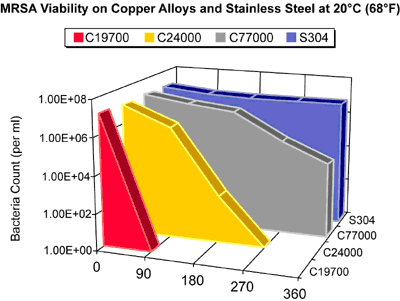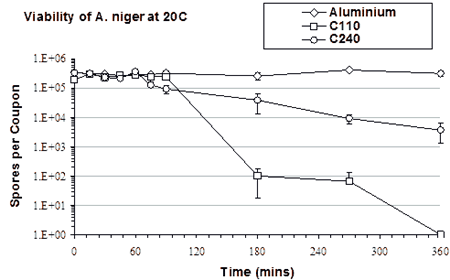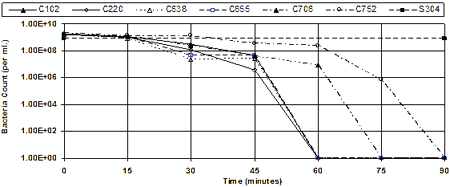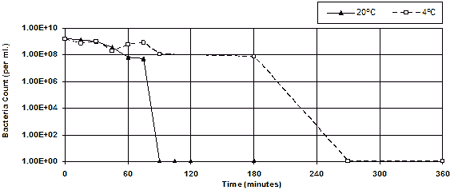September 28, 2005
FOR IMMEDIATE RELEASE
A 2000-year history of the antimicrobial applications of copper metals has given rise to current efforts to determine their effectiveness in stemming infectious disease in healthcare and other public facilities, the food processing industry, and HVAC (heating, air conditioning and ventilation) applications.
Recent studies sponsored by the Copper Development Association Inc. (CDA) and the International Copper Association, Ltd., have shown that uncoated copper and copper alloys can inactivate common disease-causing bacteria, such as E. coli ( Figure 1), streptococcus and staphylococcus. Copper alloy surfaces have even proven effective against one of the more virulent strains of antibiotic-resistant bacteria associated with hospital-acquired infections, such as Methicillin-resistant Staphylococcus aureus (MRSA). ( Figure 2) The studies were conducted by Drs. William Keevil, Sandra Wilks and Jonathon Noyce at the University of Southampton, U.K.
 Figure 1a. Epifluorescence Image after Staining with Fluorophore of E. coli on S30400 after 90 Minutes at 20 °C.
Figure 1a. Epifluorescence Image after Staining with Fluorophore of E. coli on S30400 after 90 Minutes at 20 °C. Figure 1b. Epifluorescence Image after Staining with Fluorophore of E. coli on C10200 after 90 Minutes at 20°C.
Figure 1b. Epifluorescence Image after Staining with Fluorophore of E. coli on C10200 after 90 Minutes at 20°C. Figure 2. Methicillin-resistant Staphylococcus aureus (MRSA) bacteria thrive on stainless steel (blue) but die off quickly on copper (red) and copper alloy surfaces.
Figure 2. Methicillin-resistant Staphylococcus aureus (MRSA) bacteria thrive on stainless steel (blue) but die off quickly on copper (red) and copper alloy surfaces.According to Dr. Harold T. Michels, CDA's vice president for technology and information services, MRSA was eliminated in laboratory studies on brass surfaces in 4.5 hours, and on pure copper in just 1.5 hours. Brass surfaces also inactivated the often deadly E. coli O157:H7 in less than two hours. On stainless steel, used for typical hospital and food-processing hardware, the pathogens can survive unabated for more than 30 days. Michels says it's been shown that the higher the copper content of the alloy, the more quickly bacteria die.
CDA is now conducting independent laboratory testing of five alloys on five different pathogens. These laboratory results will be presented to the U.S. Environmental Protection Agency as part of the process to obtain registration for health claims under the Federal Insecticide, Fungicide and Rodenticide Act (FIFRA). Results are expected in mid-2006. If successful, copper will become the first and only metal to be granted a health claim from EPA.
Michels says the potential for the copper industry is great. "It may expand existing markets and open the door to new ones. Included among possible applications are door knobs and handles, push plates, countertops and work surfaces, railings, grab bars, sinks, condenser coils, evaporator pans, heat fins, and food-processing equipment."
Background
Before it was recognized that microorganisms existed, the Egyptians, Greeks, Romans and Aztecs used copper compounds for the treatment of disease and good hygiene. Egyptians used copper as a sterilization agent for drinking water and wounds. Hippocrates treated open wounds and skin irritations with copper. The Romans catalogued numerous medicinal uses for copper for various diseases. The Aztecs treated sore throats with copper, while in Persia and India copper was applied to treat boils, eye infections and venereal ulcers. In the 19 th century, after microbes were discovered and the germ theory of infection linked bacteria and other microorganisms to infection and disease, scientists began to understand how copper's antimicrobial property could be harnessed to provide additional benefits. Today, the antimicrobial uses of copper have been expanded to include fungicides, antifouling paints, antimicrobial medicines, oral hygiene products, hygienic medical devices, antiseptics and a host of other useful applications.
Touch Surfaces
In a 2000 report, The Centers for Disease Control and Prevention (CDC) estimates hospital-acquired infections (HAI), such as Methicillin-resistant Staphylococcus aureus (MRSA), at more than 2 million per year in the USA, resulting in nearly 90,000 deaths annually. The CDC report also estimates that resistant infections cost health facilities $4.5-$5.0 billion per year. Community-acquired infections are also on the rise. Surfaces in such facilities as nursing homes, locker rooms, gymnasiums, barracks, transportation depots, schools, prisons and the like are of great concern.
Prescribed hygienic practices for sterilization of touch surfaces along with hand-washing are the first lines of defense but often go unheeded. The continuing rise in HAI suggests they are also inadequate. Adding to the problem is that there are few prospective antibiotics in the pipeline to combat evolving and resistant microbial strains. Consequently, medical, military and public communities are ill-prepared to protect patients and personnel. Meanwhile, little attention has been paid to the touch surfaces, themselves, that are a continual source of cross-contamination.
In healthcare facilities, surfaces in proximity to patients are of the most concern. Items such as door and furniture hardware ( e.g., push plates, knobs, handles, drawer pulls), bed rails, railings, IV stands, medical monitoring equipment, faucets, sinks, countertops and other work surfaces are identified as the most critical to sanitize on a regular basis. Disinfectants and even antimicrobial coatings have finite efficacy, at best. Identifying and employing surface materials that can provide continual antimicrobial protection, accommodate the demands of everyday use, and require a minimum of maintenance would help stem infections induced by cross-contamination.
Current studies hope to prove that use of copper metals for touch surfaces will provide a continual, proactive means to help reduce and/or preempt microbial pathogens in the healthcare environment. It is expected that, together with a concurrent program of good hygienic practice, the need for antimicrobial drugs and the fostering of drug-resistant microbial strains will be significantly reduced and that infection rates will decline.
HVAC
Microbial growth in HVAC systems and the potential exposure to microbial infections in the indoor air environment is a growing concern in public facilities. Fungi and pathogenic bacteria that are great threats to public health thrive in moist, dark HVAC environments.
Studies on the viability of microorganisms in HVAC systems have found high concentrations of different species on various components, such as the heat exchanger fins, cooling coils and evaporator pans. Once colonies of these species are established, they can spread quickly throughout a building structure via the HVAC system. Concentrations of microbes have been found to be significantly high in indoor air samples both in homes and in large buildings, such as offices, schools, hotels, prisons, gymnasiums, barracks and the like.
While microbes in HVAC systems are often benign, some are linked to serious health maladies, such as allergies and respiratory disease. In certain individuals, for example, exposure to potent microorganisms from HVAC systems can result in severe infections, sometimes leading to death.
HVAC systems must be routinely cleaned and maintained to reduce the levels of human exposure to pathogens. HVAC experts, however, are concerned that cleaning operations can re-release harmful microbes into the indoor air environment. To avoid this, CDA is pursuing studies to show that replacing aluminum and steel components with those made of copper or copper alloys would mitigate harmful bacteria and fungi, eliminating or reducing the need for any maintenance. Preliminary data from one study at the University of Southampton show that brass surfaces reduce Aspergillus niger, a virulent fungus, by about 99% within 6 hours; copper completely eliminates the mold within 6 hours; while traditional aluminum surfaces have virtually no effect. ( Figure 3)
 Figure 3. The Viability of Aspergilles niger on Surfaces of Aluminum, C24000 (brass) and C11000 (copper) at 20°C.
Figure 3. The Viability of Aspergilles niger on Surfaces of Aluminum, C24000 (brass) and C11000 (copper) at 20°C.Some recent attempts have been made to use antimicrobial coatings on HVAC components; however, by using solid copper metal components, it is expected that they would continuously and significantly reduce the amount of microorganisms circulated through the downstream air and, in turn, improve indoor air quality and reduce infections.
Food Processing
Copper's antimicrobial properties are a potential solution to help prevent cross-contamination and subsequent human infections emanating from the food-processing industry. Chief among the pathogens of concern are Listeria and E. coli that affect beef, pork and poultry products. In 2002, there were 66 major recalls related to more than 60 million pounds of contaminated food products. And, the problem is growing. Those numbers are a three-fold increase from the preceding year. The U.S. Department of Agriculture cites more than 62,000 cases of infection from E. coli O157:H7 each year incurring an annual cost impact of nearly $660 million. An estimated 1,600 cases of Listeriosis cause more than 400 deaths annually.
This suggests that current hygienic practices are inadequate and puts the public at risk. One approach to supplement them relates to the physical contact of food with various touch surfaces during processing. It is imperative that these surfaces do not facilitate the spreading of pathogenic microbial contamination. Even better would be touch surfaces with inherent antimicrobial properties that could quickly and effectively inactivate foodborne pathogens.
CDA studies demonstrate the efficacy of copper and copper alloys to inactivate foodborne microbes at room and chill temperatures. They show that stainless steel, the most common touch surface material in the food-processing industry, has little or no efficacy in combating contamination. ( Figures 4 and 5)
 Figure 4 . The Viability of Listeria monocytogenes on the Surfaces of Alloys UNS C10200, C22000, C63800, C70600, C75200 and S30400 at 20°C (68° F).
Figure 4 . The Viability of Listeria monocytogenes on the Surfaces of Alloys UNS C10200, C22000, C63800, C70600, C75200 and S30400 at 20°C (68° F). Figure 5. E. coli O157:H7 Viability on Alloy UNS C11000 Surfaces at 20°C and 4°C (68 °F).
Figure 5. E. coli O157:H7 Viability on Alloy UNS C11000 Surfaces at 20°C and 4°C (68 °F).Bottom Line
"The challenge now," says Michels, "is to engage health authorities, equipment manufacturers, regulators and other stakeholders in taking the next steps to continue their research and pursue product development using the most compatible copper alloys for appropriate applications." This will require balancing the antimicrobial efficacy of copper alloys with other required attributes, such as formability, durability, ease of fabrication, aesthetic appeal, surface finishes, corrosion resistance, tarnish resistance and reactivity to foods, disinfectants and cleaning solutions. "By this time next year, he says, we expect there will be a solid base upon which to put man's oldest metal to work throughout the world to help protect us from infectious disease."
###
